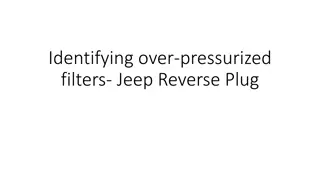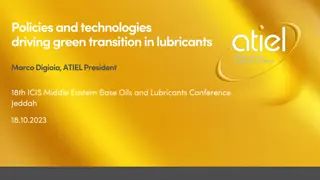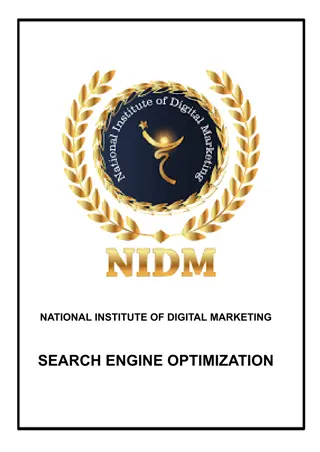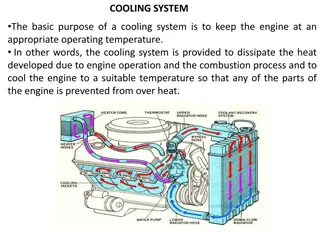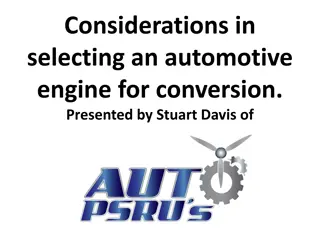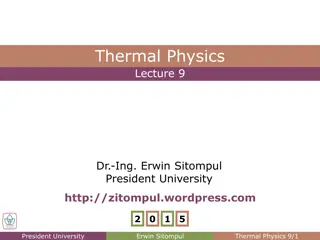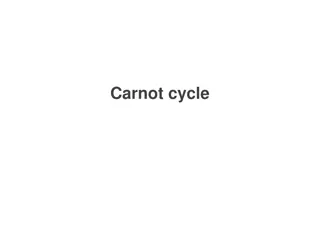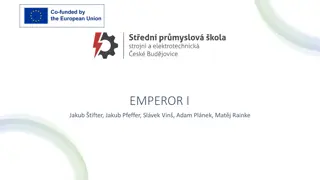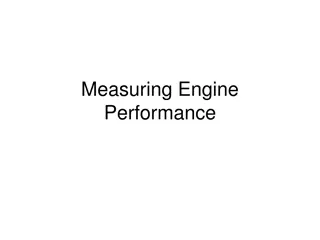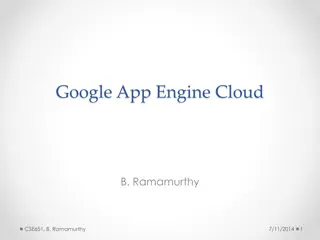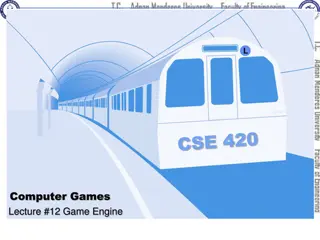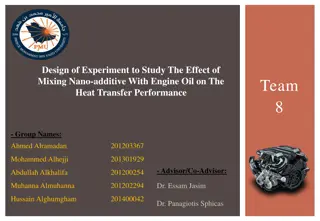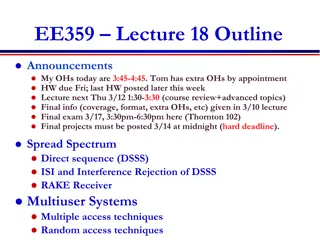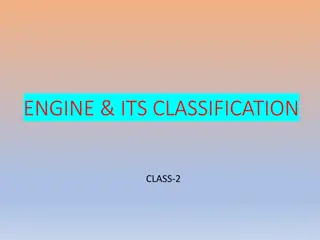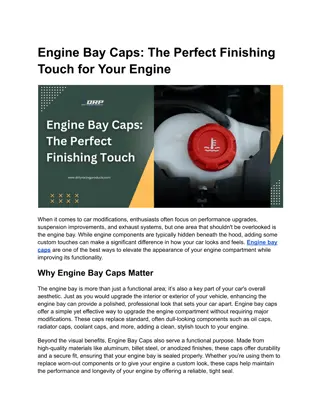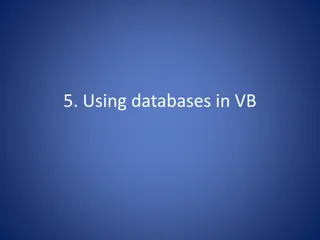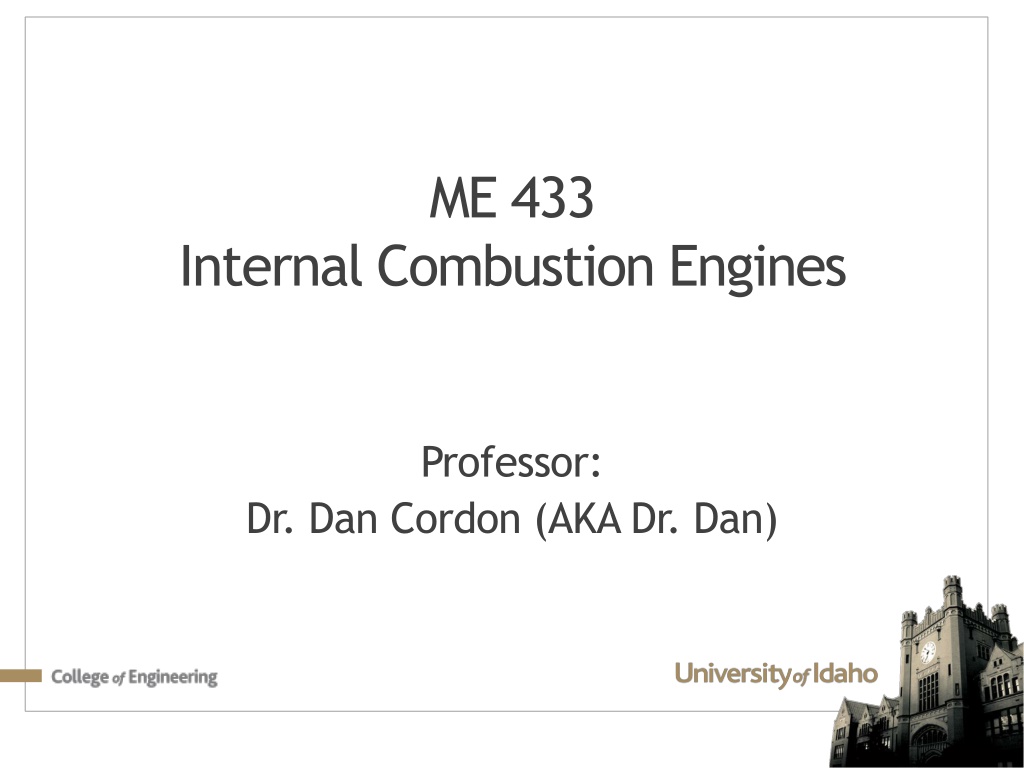
Understanding Internal Combustion Engines and Cylinder Arrangements
Dive into the world of internal combustion engines with details on four-stroke and two-stroke designs, components like spark plugs and fuel injectors, cylinder arrangements, and power regulation techniques. Explore the working principles, benefits, and applications of different engine types.
Download Presentation

Please find below an Image/Link to download the presentation.
The content on the website is provided AS IS for your information and personal use only. It may not be sold, licensed, or shared on other websites without obtaining consent from the author. Download presentation by click this link. If you encounter any issues during the download, it is possible that the publisher has removed the file from their server.
E N D
Presentation Transcript
ME 433 Internal Combustion Engines Professor: Dr. Dan Cordon (AKA Dr. Dan)
Four Stroke SI Engine Stroke 1: Fuel-air mixture introduced into cylinder through intake valve Stroke 2: Fuel-air mixture compressed Stroke 3: Combustion (~constant volume) occurs and product gases expand doing work Stroke 4: Product gases pushed out of the cylinder through the exhaust valve FUEL A I R Ignition Fuel/Air Mixture Combustion Products Intake Stroke Power Stroke Compression Stroke Exhaust Stroke
Spark plug for SI engine Fuel injector for CI engine Cylinder Components Valves Clearance volume Top Center (TC) Cylinder wall Stroke Bottom Center (BC) Piston TC 0o Crank shaft 270o 90o 180o BC
Four-Stroke SI Engine Exhaust gas residual IVO - intake valve opens, IVC intake valve closes EVO exhaust valve opens, EVC exhaust valve opens Xb burned gas mole fraction
Two Stroke SI Engine Exhaust port Fuel-air-oil mixture compressed Check valve Expansion Exhaust Intake( Scavenging ) Crank shaft Fuel-air-oil mixture Ignition Compression
Two-Stroke Scavenging Cross Loop Uniflow
Two-Stroke SI Engine EPO exhaust port open EPC exhaust port closed IPO intake port open IPC intake port closed scavenging Exhaust area Intake area
Cylinder Arrangement Single-cylinder engine gives one power stroke per crank revolution (2 stroke) or two revolutions (4 stroke). The torque pulses are widely spaced, and engine vibration and smoothness are significant problems. Used in small engine applications where a small engine size is priority. Multi-cylinder engines spread out the displacement volume amongst multiple smaller cylinders. Increased frequency of power strokes produces smoother torque characteristics. Engine balance (inertia forces associated with accelerating and decelerating piston) better than single cylinder. Most common cylinder arrangements: - In-line 4-cylinder - In-line 6-cylinder - V-6 and V-8
Power Regulation (Throttling) An IC engine is basically an air engine, the more air you get into the cylinder, the more fuel you can burn, the more power you get out. The initial pressure in the cylinder is roughly equal to the pressure in the intake manifold. Pressure in the intake manifold is varied by opening and closing the throttle plate to change the pressure drop. Maximum air flow (and power) achieved at wide-open-throttle (WOT). Minimum air flow at idle Fuel Pint < Patm Patm Idle Intake manifold WOT
Basic Carburetor Design Air Flow Venturi Fuel Throttle Mixture to manifold
Fuel Injection System Air intake manifold Throttle Fuel tank During start-up the components are cold so fuel evaporation is very slow, as a result additional fuel is added through a second injecting valve
Superchargers are compressors that are mechanically driven by the engine crankshaft and thus represent a parasitic load. Patm Pint > Patm Compressor
Turbochargers couple a compressor with a turbine driven by the exhaust gas. The compressor pressure is proportional to the engine speed
The peak pressure in the exhaust system is often similar to the intake pressure. Therefore there isn t a notable change in the pumping loss associated with the exhaust/intake strokes between N/A and Turbo engines. In order to produce enough power to run compressor the turbine speed must be very fast (100k-200k rev/min). It takes time for the turbine to get up to speed so when the throttle is opened suddenly there is a delay in achieving peak power - Turbo lag. Waste gate valve controls the exhaust gas flow rate to the turbine. It is controlled by the intake manifold pressure EXHAUST FLOW INTAKE AIR
Four Stroke Compression Ignition (CI) Engine Stroke 1: Stroke 2: Stroke 3: Air is introduced into cylinder through intake valve Air is compressed Combustion (roughly constant pressure) occurs and product gases expand doing work Product gases pushed out of the cylinder through the exhaust valve Stroke 4: A I R Fuel Injector Air Combustion Products Intake Stroke Compression Stroke Power Stroke Exhaust Stroke 15
Four-Stroke CI Combustion SOI start of injection EOI end of injection SOC start of combustion EOC end of combustion Fuel mass flow rate Fuel mass burn rate 16

